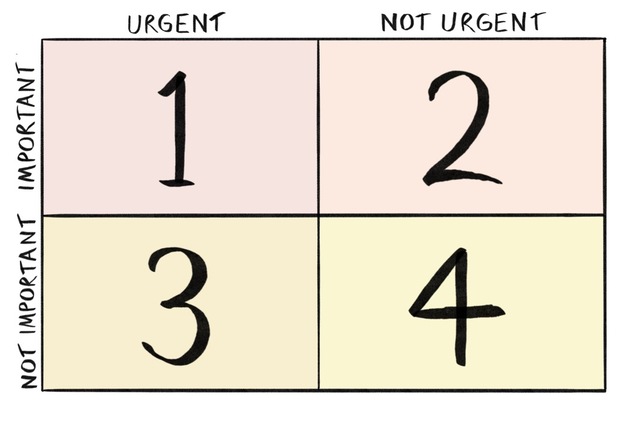Back in the 1990s, you’d be hard pushed to find an office corkboard without an Eisenhower Matrix pinned to it. Although this time management approach has become slightly unfashionable, it remains a valuable tool for dealing with overwhelm.

Each of your tasks belongs in one of four quadrants:
Quadrant 1 — Urgent and important. Here’s where you place those tasks with a screaming deadline, or unexpected emergencies, such as illnesses or exploding boilers. You have no choice but to deal with this task.
Quadrant 2 - Important but not urgent. This is the spot for tasks that are crucial to you but haven’t yet become stressful. You routinely feel in control of these activities. By keeping on top of them, you prevent bigger problems occurring in future. This could include research-related activities, such as writing, or maintaining your health.
Quadrant 3 — Urgent but not important. This is also known as Other People’s Sh*t. They’ve decided that you should do something urgently (probably because they’ve left it to the last minute), but it’s not actually your priority. You’re too busy having a crisis in Quadrant 1. If you’re teaching, this could include unreasonable last-minute requests from students, e.g. “I need you to explain the Harvard citation style in the next 5 minutes.”
Quadrant 4 — Not urgent and not important. Why do we spend any time here at all? Well, usually it’s because we’re trying to avoid tasks in Quadrants 1 or 2. This might involve watching kitten videos on YouTube, faffing about on social media, or shopping for matching stationery.
Researchers often put their writing in Quadrant 1. Although this sometimes happens despite our best efforts, your life will run more smoothly if you’re mainly inhabiting Quadrant 2: you’re working on important tasks, but they haven’t turned into mini-crises. The trouble with letting stuff slip into Quadrant 1 is that you have no wriggle room when disaster strikes, those illnesses and broken boilers demand your full attention. If you’ve left that writing deadline to the last possible moment and your boiler explodes, you have two emergencies on your hands. It’s much better to develop a steady writing schedule (and get that boiler serviced).
Exercise, cooking, and socialising often end up in Quadrant 4. Your health absolutely belongs in Quadrant 2 — this includes both your mental and physical health. If either breaks down, you can’t easily fix it. Don’t let it become an emergency. While partying every night won’t get your article finished, neglecting relationships completely can leave you isolated and without a support network. Housework is also a popular Quadrant 4 activity. It’s hard to argue with that. However, some chores might belong in Quadrant 2, such as laundry. After all, you don’t want to have to go to the library in your dressing gown.
Have you ever reached the end of a busy day and realised that you’ve achieved none of your priorities? Sometimes, we get buffeted around solving everyone else’s problems and neglecting our own. This makes us feel good about ourselves, but we don’t make progress on what’s important to us. We’re particularly susceptible to this situation in shared workspaces. There’s always someone having a crisis. If this is a problem for you, could you work somewhere else? Getting trapped in Quadrant 3 is just an insidious form of procrastination. We become helpful elves, always ready to attend to everyone else’s priorities.
The Eisenhower Matrix is an ongoing activity. You’ll need to revisit it at least weekly to reassess the situation and see what’s shifted. It might be necessary to reprioritise and use stricter criteria, especially if you’re up against a tight deadline. Thinking about your Circle of Control can be helpful, too.
Ask yourself:
- What are the urgent tasks I need to focus on this week?
- What activity do I need schedule so it doesn’t end up in Quadrant 1?
- What tasks or activities can I postpone (or let someone else do)?
- What can I drop completely?
Being clear on your priorities isn’t selfish, it’s about practising self-care. As Emily and Amelia Nagasaki say in their book Burnout, “You don’t have to set yourself on fire to keep other people warm.” 🔥
This content is adapted from my workshop on Saying No: Establishing Healthy Boundaries in Academia and my book How to Finish Your PhD.